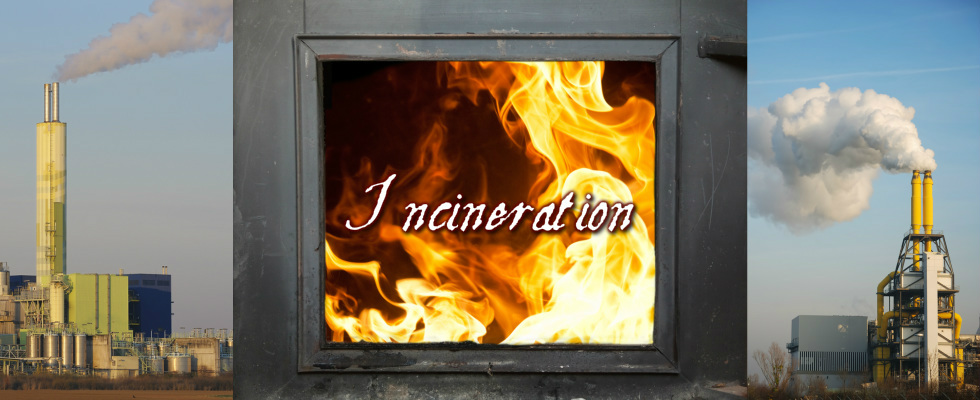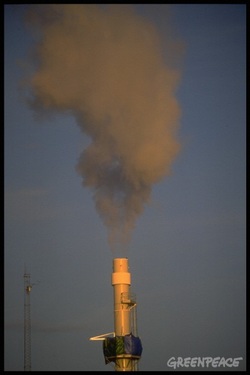
Incineration
Incineration, or combustion, is a
waste treatment process
that involves the controlled burning of municipal solid waste, which converts the waste into ash, flue gas, and heat, which can be
used to generate electricity. Incineration can also reduce the volume of solid waste and saves space in landfills,
although that space accounts to only 30-50% of the original compressed waste mass. However, despite these benefits, incineration is overshadowed by major drawbacks. Incineration of both hazardous and harmless wastes may cause emissions of substances which pollute the air, water and soil and have harmful effects on the surrounding environment and human health. According to
Zero Waste America, incinerators make waste more toxic by not actually eliminating the waste, but by changing its form into hazardous air emissions and toxic ash, converting 30% of the waste burned into toxic ash, which the EPA allows to be used as daily landfill cover, spreading hazardous toxins worldwide, contaminating air, soil, and water and acting as a major source of 210 different dioxin compounds, plus mercury, cadmium, nitrous oxide, hydrogen chloride, sulfuric acid, fluorides, and particulate matter small enough to lodge permanently in the lungs. Incineration is not a solution to the world's waste problems -
it is part of the problem. Although incinerators may reduce the volume of solid waste, they
do not dispose of the toxic substances
contained in the waste. It is a common misconception that things simply disappear when they are burned. In reality, matter cannot be destroyed; it merely changes its form. Instead of "ridding" of the waste, incinerators create the largest source of dioxins, which is one of the
most toxic chemicals known to man. Incinerators emit a wide range of pollutants in their stack gases, ashes and other residues and the filters used to clean incinerator stackgases produce solid and liquid toxic wastes, which also need to be disposed of. The only way to improve the situation is to avoid toxic waste production by improving products and processes and focusing more effort towards waste prevention, recycling and reusing products. Public opposition to incineration is growing worldwide, especially with the
"Not in My Backyard"
movement. People are recognizing that there is no place for the incineration of waste in a sustainable and healthy society.
Learn more.
Although incinerators
may reduce the volume of solid waste, they
do not dispose of the toxic substances
contained in the waste. It is a common misconception that things simply disappear when they are burned. In reality, matter cannot be destroyed; it merely changes its form. Instead of "ridding" of the waste, incinerators create the largest source of dioxins, which is one of the
most toxic chemicals known to man.
Incineration reduces our ability to reuse or recycle potentially valuable discarded materials.
Recycling offers far more environmental benefits and lower environmental, social and health impacts than other waste management options, such as incineration. Through utilizing the incineration option, valuable materials, which can be recycled and reused, are instead burned and turned into toxic ash and chemicals potentially harming, people, wildlife and ecosystems. The only way to improve the situation is to avoid toxic waste production by improving products and processes and focusing more effort towards waste prevention, recycling and reusing products.
Incineration involves the release of high levels of CO2, the main climate warming gas.
According to the
Stop Trashing the Climate Report 2008, incineration involves the release of high levels of carbon dioxide, the main global warming gas. Even when accounting for recovered energy, incineration is accompanied by
twice or more the CO2 per unit of power
than the same energy, as electricity or combined heat-and-power, produced from fossil fuels.
Learn more.
Incinerators create toxic emissions and hazardous ash.
Although incinerator fumes pass through expensive filter systems,
modern incinerators still emit significant levels of NOx
and of
ultrafine
and
nano-particles, which are of great concern because they can pass through the lung lining causing internal inflammation and penetrating to organs and even to the fetus in a pregnant mother
and can
cause heart disease.
Dioxins, the most toxic products, are officially restricted to very low emission levels by incinerator filters, but
studies show that high levels are emitted during start-up and close-down when dioxins are not monitored.
After Incineration: The Toxic Ash Problem
Incineration is usually forced through against strong public opposition.
"Today, many dozens of companies are promoting technologies such as pyrolysis, gasification, plasma arc, and catalytic cracking as a way to allegedly eliminate and “recycle” all types of waste into energy. Many of these companies falsely and boldly claim their technology is “pollution-free” and has “no emissions.” Aware of the public’s opposition to incineration, the companies promoting these technologies all claim these are not incinerators but are a “green” alternative to incineration. Despite the grandiose claims of industry, the facts prove that these technologies are in reality “incinerators in disguise” that heat the waste materials, and then burn the waste gases and emit dioxin and other pollutants into the air." ~ Incinerators in Disguise, Toxic Threat to Health, Environment, Pollution Prevention, and Renewable Energy
Incinerators pose significant health risks to humans and animals and to ecosystems and fragile habitats.
"Persistent air pollutants, such as dioxins, furans and mercury can be dispersed over large regions – well beyond local areas and even the countries from which the sources emanate. Food contaminated by an incinerator facility might be consumed by local people close to the facility or far away from it. Thus, local deposition on food might result in some exposure of populations at great distances, due to transport of food to markets. However, distant populations are likely to be more exposed through long-range transport of pollutants and low-level widespread deposition on food crops at locations remote from an incineration facility. Incineration destroys accountability and this encourages industries to go on making products that lead to problematic toxic wastes. Once the waste has been reduced to ash who can say who made what? The past 150 years has seen a progressive "toxification" of the waste stream with heavy metals, radionuclides and synthetic halogenated organic molecules. It is time to start reversing that trend. We won’t achieve that while we continue to incinerate waste" ~
National Research Council, The National Academies
(source:
Irish Doctors Environmental Association)
The Guardian: Up-To-Date News on Incineration
"Persistent air pollutants, such as dioxins, furans and mercury can be dispersed over large regions – well beyond local areas and even the countries from which the sources emanate. Food contaminated by an incinerator facility might be consumed by local people close to the facility or far away from it. Thus, local deposition on food might result in some exposure of populations at great distances, due to transport of food to markets. However, distant populations are likely to be more exposed through long-range transport of pollutants and low-level widespread deposition on food crops at locations remote from an incineration facility. Incineration destroys accountability and this encourages industries to go on making products that lead to problematic toxic wastes. Once the waste has been reduced to ash who can say who made what? The past 150 years has seen a progressive "toxification" of the waste stream with heavy metals, radionuclides and synthetic halogenated organic molecules. It is time to start reversing that trend. We won’t achieve that while we continue to incinerate waste" ~
National Research Council, The National Academies
(source:
Irish Doctors Environmental Association)
"Waste incineration does not eliminate the need for landfills. When mixed municipal waste is burned in an incinerator it does not disappear completely. A large amount of solid residue called bottom ash is left behind. This is about 30 per cent of the original weight of the waste and occupies 40-50 per cent of the space that compacted unburned waste would. This ash still has to be disposed of in landfill sites. Bottom ash may be toxic as it contains some of the heavy metals and dioxins present in the things that were burned. When it is landfilled these pollutants may eventually leak into groundwater from where it is virtually impossible to clean them up. Moreover in ash form, the toxins are more liable to leach than if they are in unburned waste." ~ Wilderness Committee
"Despite reductions of some chemicals in stack emissions, modern incinerators nevertheless still emit numerous toxic substances to the atmosphere as well as in other residues such as fly ash and bottom ash. Moreover, reductions of dioxins and other chemicals in stack gases commonly leads to increased releases of these same chemicals in the other incinerator residues. In most cases, health effects which have been associated with incinerators cannot be tied down to a particular pollutant. Together with the limited data available, it is, therefore, impossible to predict health effects of incinerators either new or updated installations. With such factors in mind, this report demonstrates that there is an urgent need for the complete phase out of incineration and the implementation of sound waste management policies based on waste prevention, re-use and recycling. All types of incinerators release pollutants to the atmosphere in stack gases, ashes and other residues. A multitudinous array of chemicals is released, including innumerable chemicals that currently remain unidentified. The chemicals present in stack gases are often also present in ashes and other residues. Such chemicals include dioxins, polychlorinated biphenyls (PCBs), polychlorinated napthalenes, chlorinated benzenes, polyaromatic hydrocarbons (PAHs), numerous volatile organic compounds (VOCs), and heavy metals including lead, cadmium and mercury. Many of these chemicals are known to be persistent (very resistant to degradation in the environment), bioaccumulative (build up in the tissues of living organisms) and toxic. These three properties make them arguably the most problematic chemicals to which natural systems can be exposed. Some of the emitted chemicals are carcinogenic (cancer-causing) and some are endocrine disruptors. Others such as sulphur dioxide (SO2) and nitrogen dioxide (NO2) as well as fine particulate matter, have been associated with adverse impacts on respiratory health." ~ Incineration and Human Health, State of Knowledge of the Impacts of Waste Incinerators on Human Health. Michelle Allsopp, Pat Costner and Paul Johnston Greenpeace Research Laboratories, University of Exeter, UK



